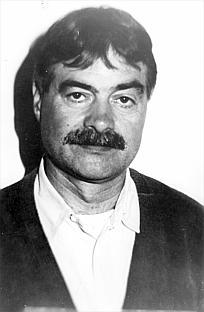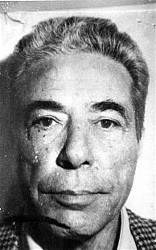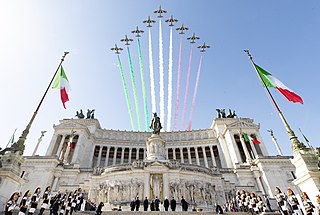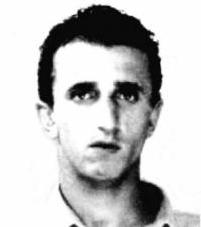| Direzione Investigativa Antimafia | |
|---|---|
| Active | Since 1991 |
| Country | Italy |
| Allegiance | Polizia di Stato Arma dei Carabinieri Guardia di Finanza Polizia Penitenziaria |
| Type | Interforce investigation office |
| Role | Contrast of mafia |
| Part of | Department of Public Security (Italian Ministry of the Interior) |
| Headquarters | Rome and other 20 peripheral offices |
| Motto(s) | Vis Unita Fortior (Strength United is Stronger) |
| Website | http://direzioneinvestigativaantimafia.interno.gov.it |
| Commanders | |
| Director | Maurizio Vallone |
The Direzione Investigativa Antimafia (DIA), also known as the Anti-Mafia Investigation Division, is an Italian multi-force investigation body under the Department of Public Security of the Ministry of the Interior. Its main task is the fight against the mafia-related organized crime in Italy.
DIA was established with the law decree n. 345 of 29 October 1991, [1] following the intensification of the fight against the Sicilian Mafia in Italy, just before the killing of magistrate Giovanni Falcone, the main inspiration and promoter, and was created with the urgent decree during the Andreotti VII government and Italian Minister of Justice Claudio Martelli as a police multy-force body (Carabinieri, Polizia di Stato and Guardia di Finanza).
The DIA was established just before the Direzione Nazionale Antimafia ('National Anti-Mafia Directorate'), with its national anti-mafia prosecutor, and the direzioni distrettuali antimafia ('Districtual Anti-Mafia Directorates'), spread on all the Italian territory within the 26 Court of Appeal. [2] The first director of DIA was the general of Carabinieri Giuseppe Tavormina. [3]
Since 2013, as a police force with general competence, the Polizia Penitenziaria has been part of the DIA organics according to the legislative decree n. 218 of 15 November 2012. [4]
The DIA is a specialized investigation body with the exclusive task of ensuring the proceeding, in a coordinated form, of the preventive investigation activities regarding the organized crime, and to carry out judiciary police investigations related exclusively to crimes attributable to like-mafia associations. [5]
It is an inter-force composition; members are selected from those of the Italian police forces and from the civil personnel of the internal administration (belonging to the public security). [6]
DIA has its own collocation within the Department of Public Security. It has full administrative-financial and management autonomy and its organization is defined by the Ministry of Interior with proper decrees, after consulting the Consiglio generale per la lotta alla criminalità organizzata ('General Council for the Contrast Against Organized Crime'). [7]
At the top of the structure there is a director, chosen in rotation between general officers of Guardia di Finanza and Carabinieri as well as senior directors of Polizia di Stato who had matured a specific competence in the field of the fight against organized crime. [8] In the exercise of his functions, the director is joined to two deputy director, and to one of them is given also the vicarious function, who have the task of overseeing respectively the operative and administrative activities. [8]
The organization is formed by a central building in Rome, articulated in a cabinet division, 3 departments ('Preventive Investigations', 'Judicial Investigations' and 'International Relations for Investigation Purposes') and 7 offices. [8] DIA has a peripheral structure formed by 12 operative centers (Turin, Milan, Genoa, Padua, Florence, Rome, Naples, Bari, Reggio Calabria, Palermo, Catania, Caltanissetta [9] ) and 9 operative sections (Trieste, Salerno, Lecce, Catanzaro, Messina, Trapani, Agrigento, Bologna, Brescia [9] ).
DIA has the tasks of performing investigations of judiciary police related to crimes of mafia-type association and it ensures the progress of preventive investigation activities regarding organized crime.
The director of DIA can propose to courts, competent for territory, the imposition of preventive measures both personal (like special surveillance) and patrimonial (seizure of assets) kind. In particular, the DIA, coordinated by Anti-mafia National Prosecutor, and the anti-mafia district directorates use their instruments as well as the Central DNA laboratory of Polizia Penitenziaria for own investigations.
From 1992 to 31 December 2018, DIA seized assets for over €17 billions and confiscation for almost €10 billions. [10] Moreover, in the same period, about 10 501 people accused of mafia association had been arrested. [10]
The Camorra is an Italian Mafia-type criminal organization and criminal society originating in the region of Campania. It is one of the oldest and largest criminal organizations in Italy, dating to the 17th century. The Camorra's organizational structure is divided into individual groups called "clans". Every capo or "boss" is the head of a clan, in which there may be tens or hundreds of affiliates, depending on the clan's power and structure. The Camorra's main businesses are drug trafficking, racketeering, counterfeiting, and money laundering. It is also not unusual for Camorra clans to infiltrate the politics of their respective areas.

The Polizia di Stato is one of the national police forces of Italy. Alongside the Carabinieri, it is the main police force for providing police duties, primarily to cities and large towns, and with its child agencies it is also responsible for highway patrol (autostrade), railways (ferrovie), airports (aeroporti), customs as well as certain waterways, and assisting the local police forces.

Law enforcement in Italy is centralized on a national level, carried out by multiple national forces, helped by few limited local agencies. The Italian law enforcement system is considered complex, with multiple police forces and other agencies taking part in different duties. Policing in the Italian system refers to the duties of "full-powered officers" coming from the four national main forces: Polizia di Stato, Carabinieri, Polizia Penitenziaria and Guardia di Finanza. While the duties of these four corps' include investigating arresting, other local forces carry out limited duties.

Salvatore Lo Piccolo, also known as "the Baron", is a Sicilian mafioso and one of the most powerful bosses of Palermo, Sicily. Lo Piccolo rose through the ranks of the Palermo mafia throughout the 1980s and he became the capomandamento of the San Lorenzo district in 1993, replacing Salvatore Biondino, who was sent to prison. Lo Piccolo was a fugitive since 1983 and had been running his Mafia affairs in hiding. With the capture of Bernardo Provenzano on 11 April 2006, Lo Piccolo had been cementing his power and rise to the top of the Palermo Mafia until his own arrest on 5 November 2007. It is believed that his family spread across Europe due to rising tensions, settling in England, Portugal, and southern Spain.

The State Forestry Corps was a national police agency in Italy. It was established on 15 October 1822 by Charles Felix of Sardinia as Amministrazione forestale per la custodia e la vigilanza dei boschi. The five Italian autonomous regions have their own corps of forestry police under regional or provincial control, which have not been disbanded. CFS was dissolved on December 31, 2016, and all personnel become militarized and absorbed by the Carabinieri's Comando unità per la tutela forestale, ambientale e agroalimentare.

Benedetto Santapaola, better known as Nitto, is a prominent mafioso from Catania, the main city and industrial centre on Sicily's east coast. His nickname is il cacciatore, because of his passion for shooting game.

Giuseppe Farinella was a Sicilian mafioso, boss of the San Mauro Castelverde family and a one-time member of the Sicilian Mafia Commission.

Festa della Repubblica is the Italian National Day and Republic Day, which is celebrated on 2 June each year, with the main celebration taking place in Rome. The Festa della Repubblica is one of the national symbols of Italy.

Giuseppe Piromalli, is an Italian criminal known as a member of the 'Ndrangheta in Calabria. He succeeded his uncle Girolamo Piromalli as head of the family clan that controls the port of Gioia Tauro and is one of the major powers in the 'Ndrangheta. He became a member of La Provincia, a provincial commission of the 'Ndrangheta, formed at the end of the Second 'Ndrangheta war in September 1991 to avoid further internal conflicts.

Giuseppe Morabito, nicknamed 'u tiradrittu, is an Italian criminal and a historical boss of the 'Ndrangheta, a Mafia-type organisation in the region of Calabria (Italy). He hails from Africo in the Locride. He was a fugitive from 1992 and included in the list of most wanted fugitives in Italy until his arrest in February 2004.
The Raggruppamento Operativo Speciale (ROS), or Special Operations Group, is part of the Italian Carabinieri.
The Barbaro 'ndrina is a powerful clan of the 'Ndrangheta, a criminal and mafia-type organisation in Calabria, Italy. The 'ndrina belongs to the locale of the town of Platì. According to the Direzione Investigativa Antimafia, the Barbaro 'ndrina is one of the most important, if not the most important and powerful 'Ndrangheta clans, not only based in Calabria, but also in the northern Italian regions of Lombardy, Piemonte and overseas in Australia, in particular in the Griffith, New South Wales area.

Gerlandino Messina is a member of the Mafia in Sicily from Porto Empedocle. He was on the most wanted list of the Italian ministry of the Interior from 1999 to 2010 when he was captured in Favara.

The Ministry of Economy and Finance, also known by the acronym MEF, is a ministry of the Italian government. Its responsibilities include overseeing economic policy, public investments and spending. The Ministry's headquarters are located in Rome's historic Palazzo delle Finanze. The current minister in the Meloni Cabinet is Giancarlo Giorgetti.
The Polizia Postale e delle Comunicazioni is one of the units of the Polizia di Stato, the State Police of Italy. Its functions include the investigation of cybercrime.
The term State-Mafia Pact describes an alleged series of negotiations between important Italian government officials and Cosa Nostra members that began after the period of the 1992 and 1993 terror attacks by the Sicilian Mafia with the aim to reach a deal to stop the attacks; according to other sources and hypotheses, it began even earlier. In summary, the supposed cornerstone of the deal was an end to "the Massacre Season" in return for a reduction in the detention measures provided for Italy's Article 41-bis prison regime. 41-bis was the law by which the Antimafia pool led by Giovanni Falcone had condemned hundreds of mafia members to the "hard prison regime". The negotiation hypothesis has been the subject of long investigations, both by the courts and in the media. In 2021, the Court of Appeal of Palermo acquitted a close associate of former prime minister Silvio Berlusconi, while upholding the sentences of the mafia bosses. This ruling was confirmed by the Italian Supreme Court of Cassation in 2023.
Angelo Jannone is a former Italian colonel and commandant at carabinieri's corp, business consultant, manager, professor of criminology and writer. He is best known as one of the first infiltrators within the mafia and narcos families and as close collaborator of the judge Giovanni Falcone. He acted undercover in Colombian drug traffickers organizations linked to Camorristi and 'ndrine. His infiltration allowed seizure of 280 kilos cocaine and the arrest of over 40 people between Naples, Milan, Rome, Amsterdam and Venezuela. After his military career he subsequently joined the Telecom Italia Group as a manager. There, he fell under investigation for illegal counter-intelligence activities in the 2004 Telecom trial. He was accused by one of the people already under investigation, this accuser was subsequently convicted. During the trial he resigned from his position as manager in order to defend himself in the trial in which he was subsequently acquitted.
The Mancuso 'ndrina is a very powerful clan of the 'Ndrangheta, a criminal and mafia-type organisation in Calabria, Italy. The 'ndrina is based in Limbadi and Nicotera and is considered by the investigative bodies as the most influential clan in the province of Vibo Valentia.
The Police ranks of Italian police officers denote the position of a given officer in the police hierarchy in Italian police forces.
Giuseppe Tavormina was an Italian General officer of the Arma dei Carabinieri and former head of the DIA and of CESIS.
Artt. 5–9
La Direzione investigativa antimafia (Dia) ha il suo direttore operativo. E' il generale dei carabinieri Giuseppe Tavormina.
Art. 8, § 1C
Art. 108, § 9.
Il generale di Corpo d' armata Carlo Alfiero lascia la Direzione investigativa antimafia (Dia) [...]. Al suo posto in via di Priscilla si insedia Agatino Pappalardo, che da oggi sarà il nuovo direttore della Dia.